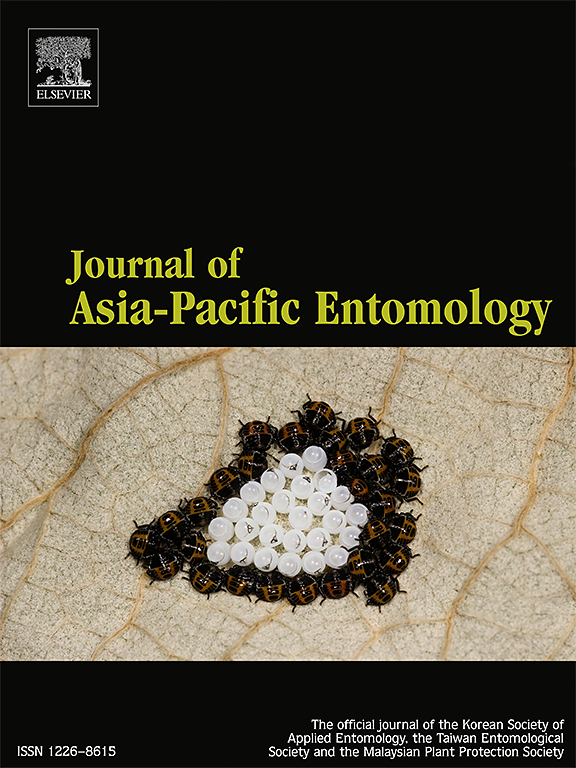Evaluation of recommended concentrations of eight insecticides for whitefly (Bemisia tabaci) control in the Republic of Korea
IF 1.1
3区 农林科学
Q3 ENTOMOLOGY
引用次数: 0
Abstract
Since its introduction in 1998, Bemisia tabaci has become a major pest affecting greenhouse crops in the Republic of Korea. Insecticidal treatment remains the primary strategy for controlling B. tabaci. The initially introduced B. tabaci populations, identified as the B biotype, were susceptible to neonicotinoids and pyriproxyfen. However, the subsequent dominance of the Q biotype, coupled with the development of insecticide resistance, has necessitated a reassessment of insecticide concentrations. This study evaluated the efficacy of eight commercial insecticides with different modes of action against a laboratory strain (Q biotype) using a leaf-dip assay. The resistance index (RI), defined as the LC90 value divided by the recommended concentration (RC), was employed to assess resistance levels. Four insecticides, pyridaben, milbemectin, spinetoram, and cyantraniliprole, were found to be effective, with RI values below 1. Spiromesifen and sulfoxaflor showed RI values of 1.7 and 5.6, respectively, indicating a need for alternative strategies to ensure effective field control. Notably, the laboratory strain, even after ten years without insecticide exposure, exhibited RI values of 23.8 and 51.3 for thiacloprid and pyriproxyfen, respectively, showing less than 50% control efficacy at 1x RC treatment. These findings underscore the inadequacy of current RCs for commercial products, which were originally established based on bioassays of the B biotype strain. To effectively manage B. tabaci, the RCs of commercial insecticides must be recalibrated based on the susceptible strain of the Q biotype, now the dominant biotype in Korea.

评价大韩民国控制烟粉虱的八种杀虫剂的推荐浓度
自1998年引进以来,烟粉虱已成为影响大韩民国温室作物的主要害虫。杀虫处理仍然是控制烟粉虱的主要策略。初步引进的烟粉虱种群被鉴定为B型,对新烟碱类和吡丙醚敏感。然而,随后Q型的优势,加上杀虫剂抗性的发展,需要重新评估杀虫剂浓度。本研究利用叶片浸渍法评估了8种不同作用方式的商用杀虫剂对一种实验室菌株(Q生物型)的药效。抗性指数(RI)定义为LC90值除以推荐浓度(RC),用于评估抗性水平。4种杀虫剂,除虫灵、蜜霉素、spinetoram和氰虫腈均有效,RI值均小于1。螺虫胺和亚砜的RI值分别为1.7和5.6,表明需要采取替代策略以确保有效的田间控制。值得注意的是,即使在没有杀虫剂接触十年后,实验室菌株对噻虫啉和吡丙醚的RI值分别为23.8和51.3,在1倍的RC处理下,其控制效果不到50%。这些发现强调了目前商业产品RCs的不足,这些RCs最初是基于B生物型菌株的生物测定而建立的。为了有效地管理烟粉虱,必须根据目前在韩国占主导地位的Q型易感菌株重新调整商业杀虫剂的rc。
本文章由计算机程序翻译,如有差异,请以英文原文为准。
求助全文
约1分钟内获得全文
求助全文
来源期刊

Journal of Asia-pacific Entomology
Agricultural and Biological Sciences-Insect Science
CiteScore
2.70
自引率
6.70%
发文量
152
审稿时长
69 days
期刊介绍:
The journal publishes original research papers, review articles and short communications in the basic and applied area concerning insects, mites or other arthropods and nematodes of economic importance in agriculture, forestry, industry, human and animal health, and natural resource and environment management, and is the official journal of the Korean Society of Applied Entomology and the Taiwan Entomological Society.
 求助内容:
求助内容: 应助结果提醒方式:
应助结果提醒方式:


